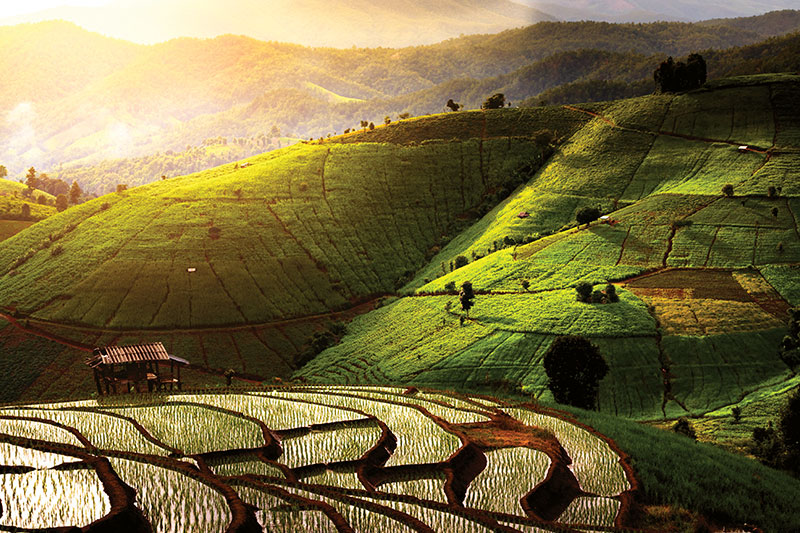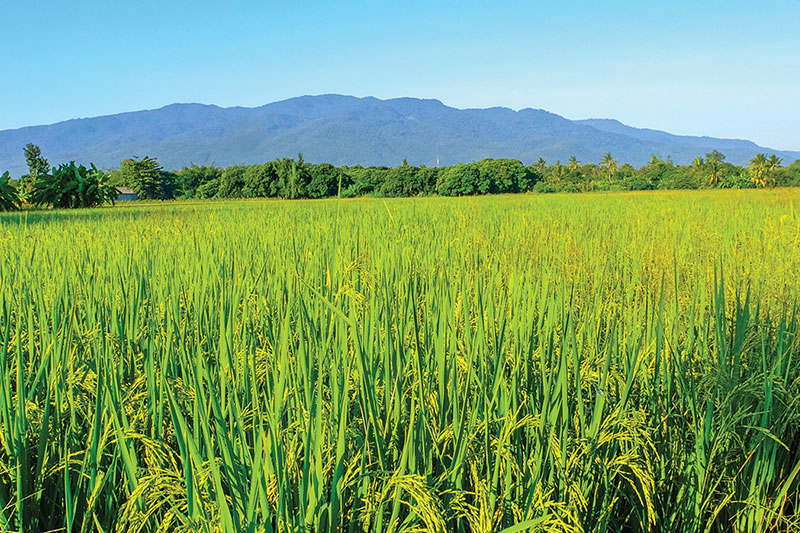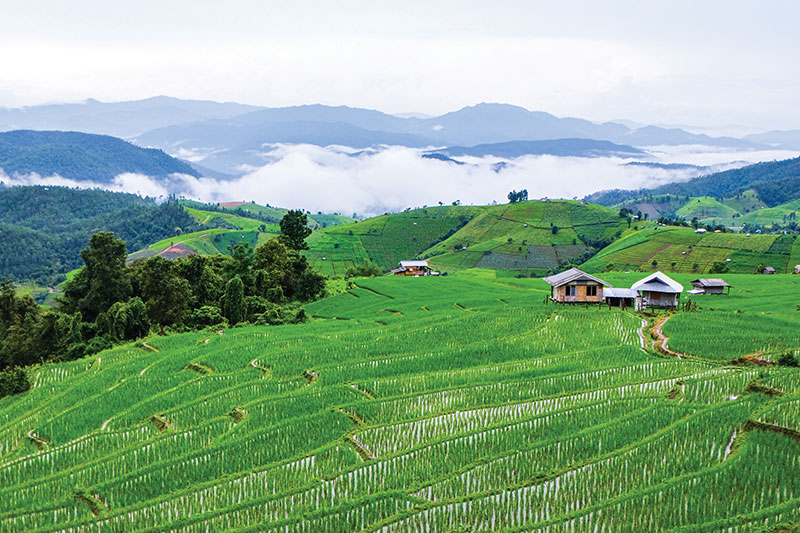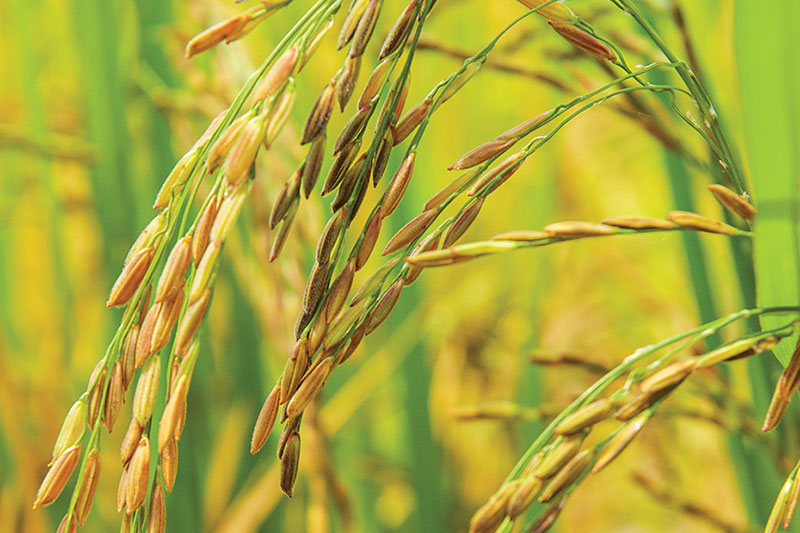
Delve into Thai Rice Culture
The nation’s favourite grain is also a gateway to its age-old traditions and seasonal rhythm
Words: Ron Emmons
Photos: Ron Emmons & Shutterstock
Throughout Southeast Asia, rice (Oryza sativa) is the staple food; yet it is more than just food – it has shaped the history, culture and economy of the entire region, and Thailand is no exception. A common Thai greeting is “Have you eaten rice yet?”, to which a positive answer is proof of wellbeing. And while many of us eat rice regularly, few of us know what happens to it before it appears on our plate. So, let’s take a closer look at the steps in rice production and the rhythms of the rice-growing season.
The start of the rice-growing year in Thailand is marked by the Royal Ploughing Ceremony, a Brahmin ritual that dates back to the Sukhothai era (1257-1350) and takes place at an astrologically auspicious time, usually in May. Ceremonial bulls plough a small part of Sanam Luang on Rattanakosin Island in Bangkok, after which the Lord of the Harvest scatters seeds that have been blessed by the king and predicts the abundance of the coming season’s harvest from foods the bulls select from seven troughs proffered to them. At the end of the ceremony, barriers are removed and farmers rush to grab handfuls of the scattered grain int eh belief that it will guarantee them a bumper crop. The practice faded out in the early 20th century but was revived by King Bhumibol in 1960, since when it has taken place each year.

When the first rains of the monsoon season appear (May or June), farmers plough their paddies, traditionally with the aid of water buffalo, in preparation for the new crop. Seeds are planted in seedbeds, and when they are about six inches high, they are transplanted into the flooded paddies. This back-breaking work is shared by the whole community, and despite having to stand for hours with “backs to the sky, faces to the earth”, as the Thai saying goes, groups of rice planters are generally in high spirits, exchanging jokes and singing songs as they slosh through ankle-deep mud and cover each paddy with an emerald-green blanket. Simple shelters dot the landscape where the farmers eat their packed lunch and snooze in the shade during the hottest time of day.
This is one of the most exciting times to be travelling around the Thai countryside, and any visitor stopping to take a photo of rice planters is likely to be invited to pitch in and lend a hand. If you don’t get an invite but would like to know what it feels like to be a rice planter, contact Sukhothai Travel Service (Sukhothai_travel@hotmail.com) to arrange a visit to the Organic Agriculture Project Sukhothai Airport, a facility operated by Bangkok Airways. Here you’ll watch various rice planting activities before kicking off your shoes and squelching into the muddy paddy to plant rice.

Although water reduces the number of weeds, the rice fields need constant attention to keep birds, rodents and insects at bay from when the rice shoots are transplanted until the harvest in November or December. When the paddies turn gold and the heads of the rice stalks droop beneath the weight of grain, the crop is harvested, using a simple, crescent-shaped knife to scythe through the stalks. Finally, the rice is threshed to remove the chaff, a process that is still done by hand in most parts of Thailand, before it is bagged up and stored in the rice barn.
As if all this exhausting work wasn’t enough, Thai farmers seek to guarantee a successful harvest by venerating Mae Phosop, the goddess of rice, and they do this through several rituals and ceremonies during the growing season. The goddess is usually represented by a small statue of a beautiful woman clutching a sheaf of rice stalks. At sowing time, the farmers build a shrine and make offerings to her, then mix new rice seds with some of the previous year’s crop to render them sacred.
Rice farmers then show thanks to the goddess when the grain begins to form, or the plant becomes “pregnant”, as Thais see it, which usually happens in September or October. At this time the women of the village take sour fruits (traditionally in Thailand pregnant women crave lime and tamarind), along with perfume, combs and mirrors to the rice paddies to present to Mae Phosop. They also erect taleo – small protective mandalas made of bamboo strips – beside the fields. Taleo means “hawk’s eye”, and they are thought to scare off potential rice raiders.
Once harvesting is complete, an offering a small part of the new crop is given to domestic animals, and the last ritual of the rice-growing season invites Mae Phosop to take up residence in the rice barn and protect the crop from disease or theft by animals such as rats. Traditionally, women perform this ritual since it is thought that if a man were to be left alone in a rice barn with the beautiful Mae Phosop, he would not be able to control his lust for her.
After the harvest is safely stored away, usually around December, rice farmers can rest from their exertions for several months during the dry, cool season before it’s time to prepare the fields for next year’s crop. This is the time to enjoy the fruits of their labours, and to consume rice in its many forms. People from North and Northeast Thailand have a preference for sticky rice over steamed rice, and eat it rolled into small balls and dipped into spicy sauces.
There is also a newly opened restaurant zone called “LOVE EAT,” under the concept “Delicious Journey for Food Lovers,” offering a culinary adventure for food enthusiasts from around the world. The zone includes dining options such as Sukishi Korean Charcoal Grill, Din Tai Fung, Okuna Sushi, Akimitsu, Wa Japanese Yakiniku, and Pancake Corner.
The latest addition to the mall is a 2,000 sqm first-in-Phuket air-conditioned indoor electric go-kart racing track, “Power Drive Karts”, on the third floor.

Sticky rice is a lot more complex to prepare than steamed rice, requiring overnight soaking, but its fans swear that no other version can satisfy hunger pangs as well as sticky rice. It is used in several delicious Thai desserts, including khao lam, for which sticky rice is pre-soaked, mixed with sugar and coconut milk and then baked in bamboo tubes. Mango and sticky rice is another exquisite combination of tastes and textures.
Rice is such a common feature of daily life in Thailand that we tend to take it for granted, but perhaps it’s time to acknowledge this bountiful gift from nature. So next time we sit down to dinner, let’s spare a thought for all the effort that went into putting the rice on our plate, and give thanks to Thailand’s rice farmers for keeping up the rhythms of rice.

10 Fun Rice Facts
- Rice provide daily sustenance for over half the world’s population
- Rice contains many of the minerals and vitamins that our bodies need, such as magnesium and Vitamin B-1
- Rice has been cultivated for around 10,000 years
- Along with sugarcane and corn, rice is one of the top three crops grown globally
- India is currently the world’s biggest exporter of rice, with Thailand second and Vietnam third
- There are over 40,000 varieties of rice (some sources say over 100,000)
- Jasmine rice (khao hom mali) is the most popular variety in Thailand
- Sticky rice (khao niao) is especially popular in North and Northeast Thailand
- It provides over a fifth of the calories consumed worldwide
- It is low in fat and cholesterol, but high in fibre, which promotes a healthy digestive system
